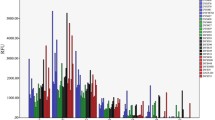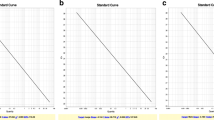Abstract
At present, the forensic DNA workflow is not capable of providing information about the contributor status (single source vs. multiple contributors) of evidentiary samples prior to end-point analysis. This exacerbates the challenges inherent to mixtures and low-template DNA samples. If additional sample information could be provided earlier in the workflow, protocols could be implemented to mitigate these challenges. An integrated Quantiplex®- high resolution melt (HRM) assay was shown to be effective in distinguishing between single source and mixture DNA samples; however, integration of the HRM assay into a more commonly used chemistry would be beneficial to the practitioner community. Thus, the assay was redesigned as an integrated Quantifiler™ Trio-HRM assay, which included the identification of a new DNA-binding dye, an increased reaction volume, and the establishment of new data analysis and standard curve metrics for all targets. This redesigned assay produced quantification values and qualitative values that were comparable to those produced when the same samples were tested using the standard Quantifiler™ Trio chemistry and settings. Further, STR profiles generated with quantification values produced from the integrated Quantifiler™ Trio-HRM assay and standard Quantifiler™ Trio chemistry were complete and fully concordant. Most importantly, the integrated Quantifiler™ Trio-HRM assay was able to accurately predict whether a sample was single source or a mixture 79.2% of the time, demonstrating the potential of this approach. With the incorporation of an expanded training set for prediction modeling, and completion of critical developmental validation studies, this assay could prove useful to the forensic DNA practitioner community.



Similar content being viewed by others
Data availability
The datasets generated during and/or analyzed during the current study are available from the corresponding author on reasonable request.
References
Smith PJ, Ballantyne J (2007) Simplified low-copy-number DNA analysis by post-PCR purification. J Forensic Sci 52(4):820–829. https://doi.org/10.1111/j.1556-4029.2007.00470.x
Forster L, Thomson J, Kutranov S (2008) Direct comparison of post-28-cycle PCR purification and modified capillary electrophoresis methods with the 34-cycle ‘low copy number’ (LCN) method for analysis of trace forensic DNA samples. Forensic Sci Int Genet 2(4):318–328. https://doi.org/10.1016/j.fsigen.2008.04.005
Ensenberger MG et al (2016) Developmental validation of the PowerPlex® Fusion 6C System. Forensic Sci Int Genet 21:134–144. https://doi.org/10.1016/j.fsigen.2015.12.011
SWGDAM, “SWGDAM Interpretation Guidelines for Autosomal STR Typing by Forensic DNA Testing Laboratories,” 2017. https://www.swgdam.org/publications. Accessed 30 Nov 2021
Clayton TM, Whitaker JP, Sparkes R, Gill P (1998) Analysis and interpretation of mixed forensic stains using DNA STR profiling. Forensic Sci Int 91(1):55–70. https://doi.org/10.1016/S0379-0738(97)00175-8
Gill P et al (2006) DNA commission of the International Society of Forensic Genetics: Recommendations on the interpretation of mixtures. Forensic Sci Int 160(2–3):90–101. https://doi.org/10.1016/j.forsciint.2006.04.009
Dror IE, Hampikian G (2011) Subjectivity and bias in forensic DNA mixture interpretation. Sci Justice 51(4):204–208. https://doi.org/10.1016/j.scijus.2011.08.004
Balding DJ, Buckleton J (2009) Interpreting low template DNA profiles. Forensic Sci Int Genet 4:1–10. https://doi.org/10.1016/j.fsigen.2009.03.003
Bieber FR, Buckleton JS, Budowle B, Butler JM, Coble MD (2016) Evaluation of forensic DNA mixture evidence: Protocol for evaluation, interpretation, and statistical calculations using the combined probability of inclusion. BMC Genet 17:1–15. https://doi.org/10.1186/s12863-016-0429-7
Nicklas JA, Buel E (2008) A real-time multiplex SNP melting assay to discriminate individuals. J Forensic Sci 53:1316–1324. https://doi.org/10.1111/j.1556-4029.2008.00877.x
Deng JQ et al (2016) Y-STR genetic screening by high-resolution melting analysis. Genet Mol Res 15:1–17. https://doi.org/10.4238/gmr.15017266
Nguyen Q, Mckinney J, Johnson DJ, Roberts KA, Hardy WR (2012) STR Melting Curve Analysis as a Genetic Screening Tool for Crime Scene Samples*. J Forensic Sci 57(4):887–899. https://doi.org/10.1111/j.1556-4029.2012.02106.x
Cloudy D (2017) Discrimination of D5S818 and D18S51 STR genotypes using LDA & PCA evaluation of high resolution melt curve data from the Qiagen Rotor-Gene® qPCR instrument. Virginia Commonwealth University, Richmond, Virginia
Wines H (2018) qPCR Genotype Determination and Mixture Detection Using High Resolution Melt Curve Analysis on the Applied Biosystems 7500 and Qiagen Rotor-Gene ® Q qPCR systems. Virginia Commonwealth University, Richmond, VA
Nicklas JA, Noreault-Conti T, Buel E (2012) Development of a Fast, Simple Profiling Method for Sample Screening Using High Resolution Melting (HRM) of STRs. J Forensic Sci 57:478–488. https://doi.org/10.1111/j.1556-4029.2011.01981.x
Kuehnert K (2015) Development of a STR Genotyping Screening Assay Using High Resolution Melting Curve Analysis of the STR Loci D5S818 and D18S51. Virginia Commonwealth University, Richmond, Virginia
Williams AL (2020) Expanded Testing of an Integrated qPCR Mixture Screening Assay Using High Resolution Melt Curve Analysis and Support Vector Machine Modeling. Virginia Commonwealth University, Richmond, Virginia
DA Torres (2022) “A QuantifilerTM Trio-based HRM Mixture Screening Assay for the QuantStudioTM 6 Flex qPCR platform,” Virginia Commonwealth University.
Applied Biosystems, “QuantifilerTM HP and Trio DNA Quantification Kits User Guide,” Apr. 2017. https://tools.thermofisher.com/content/sfs/manuals/4485354.pdf. Accessed 30 Nov 2021
Holt A, Wootton SC, Mulero JJ, Brzoska PM, Langit E, Green RL (2016) Developmental validation of the Quantifiler® HP and Trio Kits for human DNA quantification in forensic samples. Forensic Sci Int Genet 21:145–157. https://doi.org/10.1016/j.fsigen.2015.12.007
Applied Biosystems (2010) “Applied Biosystems 7500/7500 Fast Real-Time PCR System Genotyping Experiments,”.
Applied Biosystems (2022) “QuantStudioTM 6 and 7 Flex Real-Time PCR Systems Maintenance and Administration,”.
C. Dilmegani, “What is Synthetic Data? What are its Use Cases & Benefits,” Jul. 2018. https://research.aimultiple.com/synthetic-data/. Accessed 1 Dec 2021
Acknowledgements
National Institute of Justice, Grant Award No: 2019-DU-BX-0003
Funding
The research leading to these results received funding from the NIJ under Grant Agreement No 2019-DU-BX-0003.
Author information
Authors and Affiliations
Contributions
All authors contributed to the study conception and design. Material preparation, data collection and analysis were performed by Dayanara Torres, Chastyn Smith and Andrea Williams. The first draft of the manuscript was written by Chastyn Smith and all authors commented on previous versions of the manuscript. All authors read and approved the final manuscript.
Corresponding author
Ethics declarations
Ethics approval
This study was performed in line with the principles of the Declaration of Helsinki. Approval was granted by the Institutional Review Board (IRB) of Virginia Commonwealth University (VCU) protocol (HM20002931) on 01/03/2023.
Consent to participate
Informed consent was obtained from all individual participants included in the study.
Competing Interests
None.
Financial Interests
None.
Non-financial Interests
None.
Additional information
Publisher's note
Springer Nature remains neutral with regard to jurisdictional claims in published maps and institutional affiliations.
Rights and permissions
Springer Nature or its licensor (e.g. a society or other partner) holds exclusive rights to this article under a publishing agreement with the author(s) or other rightsholder(s); author self-archiving of the accepted manuscript version of this article is solely governed by the terms of such publishing agreement and applicable law.
About this article
Cite this article
Torres, D., Smith, C., Williams, A.L. et al. A quantifiler™ trio-based HRM screening assay for the accurate prediction of single source versus mixed biological samples. Int J Legal Med 137, 1639–1651 (2023). https://doi.org/10.1007/s00414-023-03070-6
Received:
Accepted:
Published:
Issue Date:
DOI: https://doi.org/10.1007/s00414-023-03070-6




